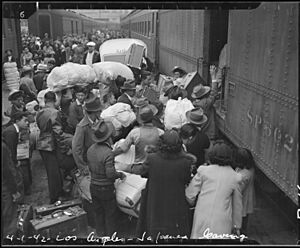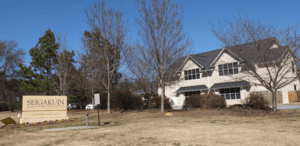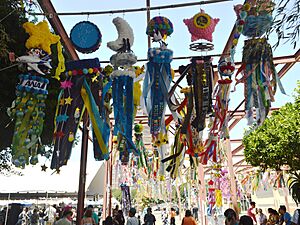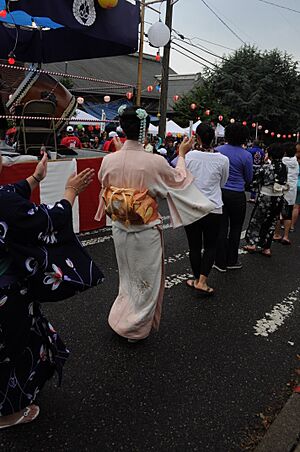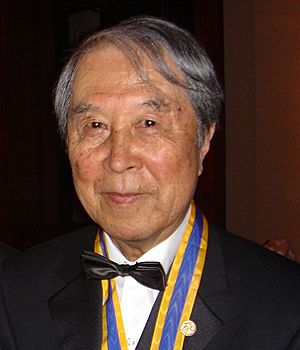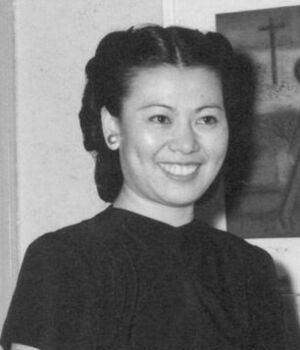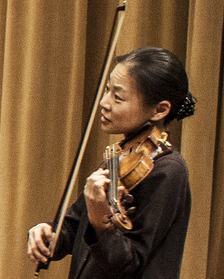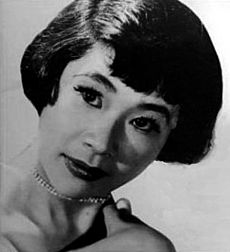Japanese Americans facts for kids
| 日系アメリカ人 | |
|---|---|
 |
|
| Total population | |
| 1,469,637 0.44% of the total U.S. population (2019) |
|
| Regions with significant populations | |
| Hawaii, the West Coast, especially in California, and urban areas elsewhere. | |
| Languages | |
| English, Japanese | |
| Religion | |
| 33% Protestantism 32% Unaffiliated 25% Buddhism 4% Catholicism 4% Shinto |
|
| Related ethnic groups | |
| Japanese people, Ryukyuan Americans |
Japanese Americans (Japanese: 日系アメリカ人) are people in the United States whose families originally came from Japan. They are an important part of the diverse American population. In the 20th century, Japanese Americans were one of the largest Asian American groups. Today, about 1.4 million people in the U.S. have Japanese roots. Many Japanese Americans live in California and Hawaii. You can also find large communities in New York, Washington, Illinois, and Ohio. Southern California has the biggest Japanese American population in North America. The city of Gardena has the most Japanese Americans in the mainland U.S.
Contents
Understanding Japanese American History
How Japanese People Came to America
People from Japan started moving to the U.S. in large numbers after 1868. This was when Japan went through big changes called the Meiji Restoration. These first immigrants were called Issei. They mostly came from small towns and farms in southern Japan. Most of them settled in Hawaii or along the West Coast. The number of Japanese people in the U.S. grew quickly. It went from just 148 in 1880 to over 24,000 by 1900.
In 1907, Japan and the U.S. made an agreement called the Gentlemen's Agreement. This stopped new unskilled Japanese workers from coming to the U.S. However, it allowed businessmen, students, and wives of Japanese immigrants to come. Before this agreement, most Japanese people in the U.S. were men. By 1924, more women had arrived.
Japanese immigration almost completely stopped in 1924. This was because the U.S. Congress passed a law called the Immigration Act of 1924. This law banned almost all Japanese people from coming to the U.S. Also, an older law from 1790 meant that Issei could not become U.S. citizens. This meant they could not vote or own land in many states. Because of these rules, very few Japanese people came to the U.S. between 1931 and 1950. Later, in 1965, a new law called the Immigration and Nationality Act of 1965 removed these bans. This allowed more people from Japan and other countries to immigrate again.
Generations of Japanese Americans
Because new immigrants were not allowed after 1924, most Japanese Americans born after that time were born in the U.S. This group is called the Nisei. They were different from the Issei because they were younger, U.S. citizens, and spoke English well. Many Nisei married other Nisei. This led to a third generation called the Sansei.
In recent years, immigration from Japan has changed. It is now similar to immigration from Europe. About 5,000 to 10,000 Japanese people come to the U.S. each year. For many, it is not just about finding better opportunities.
Internment During World War II
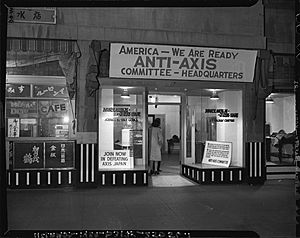
During World War II, about 120,000 Japanese Americans and Japanese citizens living on the West Coast of the United States were forced to move. They were sent to ten different camps across the Western United States. This happened because of their race or family background, not because of anything they had done. Whole families, including children, were sent to these camps together.
In 1948, a law called the Evacuation Claims Act offered some money for property that was lost. But people needed documents that many had lost during their forced move. The law also did not pay for lost jobs or wages. Less than 24,000 people filed claims, and most received only a small part of what they had lost.
Forty years later, in 1988, the U.S. government passed the Civil Liberties Act of 1988. This law officially said that the forced moves were a "fundamental violation of basic civil liberties and constitutional rights." Many Japanese Americans prefer to call these places "concentration camps" or "prisons" instead of "internment camps." This is because people were held there based on their background, not because they had committed a crime.
Japanese American Culture and Identity
Generations of Japanese Americans
Japanese Americans use special terms to describe their generations. These terms combine a Japanese number with the word sei (世), which means "generation."
- Issei (一世): This is the first generation. These are people born in Japan who later moved to another country.
- Nisei (二世): This is the second generation. These are people born in North or Latin America, Hawaii, or any country outside Japan. At least one of their parents was an Issei or a Japanese person not from Japan.
- Sansei (三世): This is the third generation. These are people born outside Japan to at least one Nisei parent.
- Yonsei (四世): This is the fourth generation. They are born outside Japan to at least one Sansei parent.
- Gosei (五世): This is the fifth generation. They are born outside Japan to at least one Yonsei parent.
The word Nikkei (日系) is a broader term. It includes all people of Japanese descent living in any country, no matter which generation they are.
Languages Spoken by Japanese Americans
The Issei and many Nisei speak Japanese as well as English. However, most younger Japanese Americans speak English as their main language. Some choose to learn Japanese later. In Hawaii, where many people have Japanese roots, Japanese is a widely spoken language. It is even taught in private schools from second grade. Signs and public transport often have Japanese writing for tourists from Japan.
After World War II, many Nisei and Sansei avoided learning Japanese. They wanted to show their loyalty to the U.S. But now, more younger generations are interested in learning Japanese. They want to connect with both their Japanese and American identities.
Importance of Education
Japanese American culture values education highly. Children are often encouraged to aim for higher education. Their scores on tests like the SAT and ACT often go above national averages. Japanese Americans also have a large number of students taking Advanced Placement tests each year.
Many Japanese Americans earn college degrees. They are sometimes called a "model minority." This idea suggests that they succeed mostly on their own. For example, sociologist William Petersen wrote in 1966 that Japanese Americans achieved great success with little help. He said that challenges only made them more determined.
Japanese Americans are still well-represented in top universities. These include Ivy League schools and campuses like Berkeley and UCLA. In 2000, over 40% of Japanese Americans had a college degree.
Schools for Japanese Language and Culture

The first Japanese school in Hawaii opened in 1893. Other Japanese schools for temporary residents followed in North America. Before World War II, many second-generation Japanese Americans went to American schools during the day. Then, they attended Japanese schools in the evening. This helped them keep up their Japanese language skills. Some parents worried about discrimination. They gave their children the choice to go back to Japan for education or stay in America and study both languages.
During World War I, there were efforts to close Japanese-language schools. But in 1927, a Supreme Court case protected the right of Japanese Americans to have private language schools. Many Japanese schools closed during the internment of Japanese Americans in World War II. After the war, many of them reopened.
Today, there are Japanese international schools in the U.S. These include Seigakuin Atlanta International School, Chicago Futabakai Japanese School, and New York Japanese School. There are also weekend Japanese classes called hoshū jugyō kō. These schools are for Japanese citizens and second-generation Japanese Americans. There are also Japanese heritage schools for later generations. These schools often teach about Japanese American history and culture.
Religious Practices
Religious Makeup of Japanese-Americans (2012) Christianity (37%) Unaffiliated (32%) Buddhism (25%) Shintoism and Other (6%)
Japanese Americans follow many different religions. Many practice Buddhism, especially forms like Jōdo Shinshū and Zen. Some also practice Shinto. A large number are Christian, usually Protestant or Catholic. Because Buddhism and Shinto have been part of Japanese society for a long time, they have shaped many Japanese cultural values.
Many Japanese Americans continue to practice Buddhism. Many community events and festivals are held at Buddhist temples. For example, the Obon Festival is very popular. It happens in the summer and is a chance to connect with customs and traditions. It also helps pass these traditions to younger generations. These festivals are common in areas with many Japanese Americans, like Southern California and Hawaii. Many Japanese people, both in Japan and outside, are not strictly religious. They might take part in Shinto or Buddhist rituals for events like weddings or funerals, rather than regular worship.
Many Japanese Americans also practice Christianity. The First Japanese Presbyterian Church of San Francisco opened in 1885. The Japanese Evangelical Missionary Society (JEMS) was formed in the 1950s. It runs Christian programs on university campuses. These groups often have Japanese language ministries.
Important Celebrations
An important yearly festival for Japanese Americans is the Obon Festival. It takes place in July or August. Across the country, Japanese Americans gather at fairgrounds, churches, or parking lots. They honor their ancestors and families with folk dances and food. Carnival games are often set up for children to play together.
Japanese American celebrations often focus on community sharing. They bring people together to enjoy their shared culture.
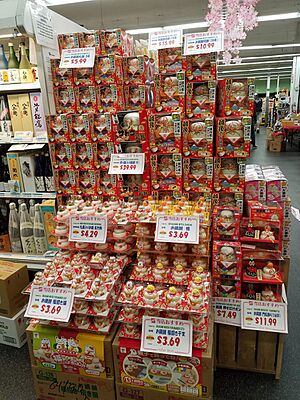
| Date | Name | Region |
|---|---|---|
| January 1 | Shōgatsu New Year's Celebration | Nationwide |
| February | Japanese Heritage Fair | Honolulu, HI |
| February to March | Cherry Blossom Festival | Honolulu, HI |
| March 3 | Hinamatsuri (Girls' Day) | Hawaii |
| March | Honolulu Festival | Honolulu, HI |
| March | Hawaiʻi International Taiko Festival | Honolulu, HI |
| March | International Cherry Blossom Festival | Macon, GA |
| March to April | National Cherry Blossom Festival | Washington, DC |
| April | Northern California Cherry Blossom Festival | San Francisco, CA |
| April | Pasadena Cherry Blossom Festival | Pasadena, CA |
| April | Seattle Cherry Blossom Festival | Seattle, WA |
| May 5 | Tango no Sekku (Boys' Day) | Hawaii |
| May | Shinnyo-En Toro-Nagashi (Memorial Day Floating Lantern Ceremony) | Honolulu, HI |
| June | Pan-Pacific Festival Matsuri in Hawaiʻi | Honolulu, HI |
| July 7 | Tanabata (Star Festival) | Nationwide |
| July–August | Obon Festival | Nationwide |
| August | Nihonmachi Street Fair | San Francisco, CA |
| August | Nisei Week | Los Angeles, CA |
Japanese Americans in Politics

Japanese Americans have strongly supported Democratic candidates in recent elections. For example, in the 2008 U.S. presidential election, 62% of Japanese Americans voted for Barack Obama. In the 2016 election, 74% voted for Hillary Clinton. In 2020, between 61% and 72% planned to vote for Joe Biden.
After Hawaii became a state in 1959, Japanese Americans gained more political power. Daniel Inouye was elected to Congress. Spark Matsunaga was elected to the U.S. House of Representatives in 1963. In 1965, Patsy Mink became the first Asian American woman elected to the U.S. Congress. Their success helped Japanese American leaders become more accepted on the national stage.
Important federal appointments include Eric Shinseki and Norman Mineta. Eric Shinseki was the first Japanese American military chief of staff. Norman Mineta was the first Japanese American federal cabinet secretary.
Japanese American members of the U.S. House of Representatives have included Daniel K. Inouye, Spark Matsunaga, Patsy Mink, Norman Mineta, Bob Matsui, Pat Saiki, Mike Honda, Doris Matsui, Mazie Hirono, Mark Takano, and Mark Takai.
Japanese American members of the U.S. Senate have included Daniel K. Inouye, Samuel I. Hayakawa, Spark Matsunaga, and Mazie Hirono. In 2010, Senator Inouye became the President pro tempore of the United States Senate. This made him the highest-ranking Asian American politician in U.S. history at that time.
George Ariyoshi was the Governor of Hawaii from 1974 to 1986. He was the first American of Asian descent to be elected governor of a U.S. state. David Ige is the current governor of Hawaii, serving since 2014.
Other Japanese Americans have also served as mayors. Kinjiro Matsudaira was elected mayor of Edmonston, Maryland, in 1927 and 1943. In 1957, James Kanno became the first mayor of Fountain Valley, California. Norm Mineta became mayor of San Jose, California, in 1971. In 1980, Eunice Sato became the first Asian American female mayor of a major American city when she was elected mayor of Long Beach, California.
Japanese American Communities Across the U.S.
Communities in the Western United States
- Hawaii: Many Japanese Americans live here.
- California:
- Greater Los Angeles: Cities like Anaheim, Cerritos, Gardena, Long Beach, California, and Los Angeles (especially Little Tokyo) have large Japanese American populations. Torrance has the largest Japanese community in North America.
- San Diego area: Communities in University City and Chula Vista.
- Central Valley, California: Areas like Fresno and Stockton have Japanese American residents.
- San Francisco Bay Area: This area has many Nisei and Sansei. Cities like San Jose (which has one of three remaining Japantowns in North America) and San Francisco are important centers.
- Washington State: Large communities are found in the Seattle area, Bellevue, and Redmond.
- Oregon: Communities in Portland and the surrounding area.
- Colorado: Denver (with its Sakura Square) and Greeley have Japanese American populations.
Communities Outside the West
- New York metropolitan area: This area has the highest number of Japanese Americans outside the West. This includes New York City, parts of Long Island, and Northern New Jersey.
- Illinois: The Chicago area, especially Arlington Heights, has a Japanese community.
- Michigan: Novi has the largest Japanese population in Michigan.
- New Jersey: Edgewater and Fort Lee have the largest concentration of Japanese Americans in the state.
- Virginia: About 5,500 Japanese Americans live in Northern Virginia.
- Washington, D.C.: This area and its suburbs in Maryland and Northern Virginia have Japanese American communities.
Notable Japanese Americans
|
James Iha
|
Yuna Ito
|
|||||
|
Harry B. Harris Jr.
|
Melody.
|
Jake Shimabukuro
|
Hayley Kiyoko
|
|||
Leaders in Science and Technology
Many Japanese Americans have become famous in science and technology. In 1979, biochemist Harvey Itano was the first Japanese American chosen for the U.S. National Academy of Sciences.
Several Japanese Americans have won the Nobel Prize. Charles J. Pedersen won the 1987 Nobel Prize in Chemistry. Yoichiro Nambu won the 2008 Nobel Prize in Physics. Shuji Nakamura won the 2014 Nobel Prize in Physics for inventing efficient blue light-emitting diodes. Syukuro Manabe won the 2021 Nobel Prize in Physics for his work on Earth's climate.
Michio Kaku is a theoretical physicist and a well-known science communicator. Ellison Onizuka was the first Asian American astronaut. He was on the Space Shuttle Challenger when it exploded. Immunologist Santa J. Ono became the first Japanese American president of a major research university.
Achievements in Art and Literature
Art and Architecture
Artist Sueo Serisawa helped create the California Impressionist style of painting. Yoko Ono's art and performances have been shown around the world. Other important Japanese American artists include Chiura Obata, Isamu Noguchi, and Ruth Asawa.
Literature
Many Japanese American writers have won awards. Miné Okubo won the American Book Award in 1984. Taro Yashima won the Children's Book Award in 1955 for his book Crow Boy. Cynthia Kadohata won the Newbery Medal in 2005 and the National Book Award for Young People's Literature in 2013.
Michiko Kakutani is a Pulitzer Prize-winning literary critic. She was the chief book critic for The New York Times for many years. Karen Tei Yamashita received the National Book Foundation's Medal for Distinguished Contribution to American Letters in 2021.
Talents in Music
Classical violinist Midori Gotō won the prestigious Avery Fisher Prize in 2001. World-famous violinist Anne Akiko Meyers also received an Avery Fisher grant. Grammy Award-winning singer-songwriter Yoko Ono has released many albums.
Other notable Japanese American musicians include singer Pat Suzuki. Rapper Mike Shinoda is from the band Linkin Park. Hiro Yamamoto was the original bassist for Soundgarden. Ukulele player Jake Shimabukuro is also well-known. Guitarist James Iha was in The Smashing Pumpkins. Singers Hikaru Utada and Joe Inoue were born in the U.S. but became famous in Japan.
Success in Sports
Japanese Americans first made a big impact in the Olympics in the late 1940s and 1950s. Harold Sakata won a silver medal in weightlifting in 1948. In 1952, Tommy Kono (weightlifting), Yoshinobu Oyakawa (swimming), and Ford Konno (swimming) all won gold medals and set Olympic records. Evelyn Kawamoto won two bronze medals in swimming in 1952.
Decades later, Eric Sato won gold and bronze medals in volleyball. His sister Liane Sato won bronze in the same sport. Bryan Clay won the decathlon gold medal in the 2008 Olympics. Apolo Anton Ohno won eight Olympic medals in speed skating. Brothers Kawika Shoji and Erik Shoji won bronze medals in volleyball in 2016.
In figure skating, Kristi Yamaguchi won the 1992 Olympic gold medal. Mirai Nagasu won the 2008 U.S. Figure Skating Championships at age 14. Alex Shibutani and Maia Shibutani are two-time national champions in ice dancing and 2018 Olympic bronze medalists.
In professional sports, Wataru Misaka played for the New York Knicks in 1947. He was the first person of color in modern professional basketball. Wally Kaname Yonamine played running back for the San Francisco 49ers in 1947. Lenn Sakata played in MLB. Rex Walters played in the NBA. Lindsey Yamasaki was the first Asian American to play in the WNBA.
Hikaru Nakamura became the youngest American to earn the title of International Grandmaster in chess at age 15. He has won the U.S. Chess Championship five times. Collin Morikawa won major golf championships in 2020 and 2021. Naomi Osaka, a tennis star, was the main torchbearer at the 2020 Olympics in Tokyo.
Stars in Entertainment and Media
Miyoshi Umeki won an Academy Award for Best Supporting Actress in 1957. Actors Sessue Hayakawa, Mako Iwamatsu, and Pat Morita were also nominated for Academy Awards.
Steven Okazaki won an Academy Award in 1990 for his documentary film. Chris Tashima won an Academy Award in 1997 for a short film. Audrey Marrs won an Academy Award in 2010 for a documentary. Kazu Hiro won the Academy Award for Best Makeup and Hairstyling twice.
Actors like Jack Soo, George Takei (from Star Trek), and Pat Morita (from The Karate Kid) helped open doors for Asian Americans in acting. Pat Morita also starred in Mr. T and Tina, the first American sitcom with an Asian lead character. Shin Koyamada had leading roles in The Last Samurai and Wendy Wu: Homecoming Warrior. Masi Oka was in the TV series Heroes. Grant Imahara appeared on MythBusters.
Cary Fukunaga is an Emmy-award-winning filmmaker. He directed the first season of True Detective and the James Bond film No Time to Die.
Japanese Americans also work as TV news anchors across the country. Notable anchors include Tritia Toyota, Adele Arakawa, and David Ono.
Images for kids
See also
 In Spanish: Inmigración japonesa en los Estados Unidos para niños
In Spanish: Inmigración japonesa en los Estados Unidos para niños



